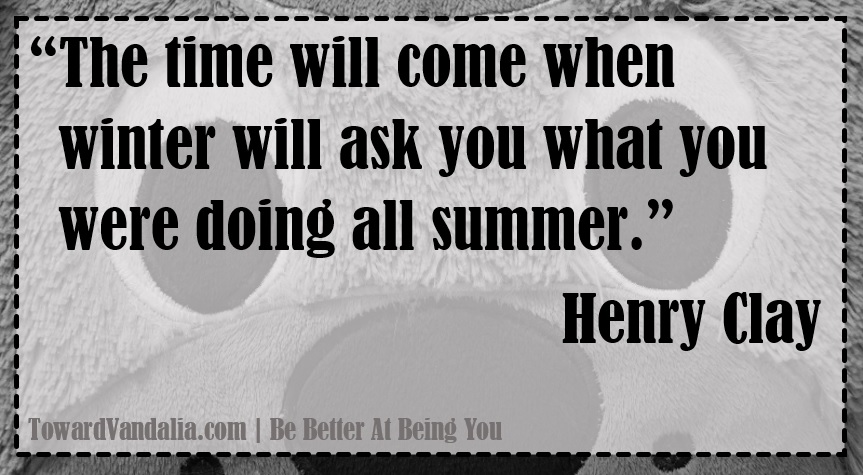
This is the second in a series of posts I have lamely dubbed YouCo. I’m drawing on lessons from my graduate business studies to show how best practices from the business world can be applied at the most micro of levels: yourself. The first post considered how a mission and vision statement might be useful to individuals and I encourage you to start there before continuing with this post. That said: I’m not your real dad so you’re free to do whatever you want.
Today’s post examines how businesses construct a strategy to help them attain their stated vision within the context of their mission. I also introduce scenario planning, an idea that is sure to tingle your creativity-senses. The series concludes next week with a look at some generic strategies that might just bring you closer to actualization. I’ll put it this way: once you’ve looked at mentorship as a merger, there’s no turning back.
Part Two: Strategy And Scenario Planning
If your mission and vision are what you are and what you want to be, respectively, then strategy is the means by which you’re going to attempt to bridge the gap between the two.
Constructing a strategy (which may go by any number of names depending on which particular annual report you happen to be reading) for a business is complex. Internal forces are complicated enough to navigate, but there is also the added consideration of a number of external factors ranging from consumer attitudes to the behavior of your competitors. An effective business strategy must maximize results for stakeholders while minimizing risk and loss – and all within a turbulent external environment over which the company has little control.
Businesses compete with each other because the nature of the marketplace presents only one pie from which they can carve out a slice. If 40 people in your neighborhood drink coffee and you decide to open a cafe, you’re competing for a percentage of those 40 people. You’re not creating a customer base, you’re competing for a piece of one that’s already there… and you always will be. A business strategy, then, must focus on maximizing the business’ slice of this pie. Rarely is a dollar of profit created; it’s usually “captured” from a competitor.
Fortunately, things are far simpler for an individual. Actualization (the assumed endpoint of our efforts) is not one big pie from which every person on the planet must carve their slice – it’s billions of individual pies just waiting to be snatched once we climb high enough to reach the shelf. I’m not claiming that there is an absence of competition for individuals. We’re all going to end up competing for jobs, promotions, etc. However, these competitions are isolated rather than ongoing and the philosophies that I’m about to introduce don’t just apply to the bigger picture, they will also help you come out on top in these intermediate battles.
Constructing And Stating Your Strategy
Your strategy statement is every bit as important as your mission and vision statements and should be concise, specific and realizable in the same manner. Such a statement is made up of three components:
- The Objective
- The Scope
- The Advantage
The objective, of course, is the end state that you would like to accomplish and (where possible to gauge) a time-frame in which you would like to achieve that state. The scope is, simply put, the context within which you hope to reach the objective. The advantage, meanwhile, is the unique set of characteristics and traits that you bring to the front of this particular war that will enable you to lead yourself and other stakeholders to the objective.
In part one we looked at the mission and vision of my alma mater, West Virginia University. WVU are seeking to achieve their mission with their 2020 Strategic Plan For The Future, a set of five goals that conceptualize the components of the university’s vision statement into (caution: buzzword ahead) action items.
Enjoy a nice cup of Goal 5 for an example:
Goal 5:
Enhance the well-being and the quality of life of the people of West Virginia.
OBJECTIVE 1
Create an academic health system and health professions programs that enhance the well-being of West Virginians.
OBJECTIVE 2
Increase opportunities for the citizens of the state through workforce education, lifelong learning, and outreach to every county.
OBJECTIVE 3
Promote sustainable economic development and a cultural environment that improve the quality of life throughout the state.
ACTIONS
1. Promote sustainable economic development and a cultural environment that improve the quality of life throughout the state.
2. Expand outreach efforts to connect the campuses to citizens and communities throughout the state. Provide resources and information to equip West Virginia University Extension agents, and other personnel engaged in outreach and care, for a broader role as ambassadors for the institution.
3. Meet regularly with state and industry leaders to articulate University successes and initiatives, to learn of the needs of the state, and to promote the commercialization of research, economic development, and global commerce.
4. Create a nimble academic health system that is responsive to patient access needs, ensures high quality, cost-effective, and safe care, and delivers patient satisfaction and value.
5. Strengthen relationships with alumni, stakeholders, and the communities that neighbor West Virginia University campuses.
This goal clearly addresses the final part of WVU’s vision statement: “By 2020, West Virginia University will attain national research prominence, thereby enhancing… the vitality and well-being of the people of West Virginia.”
This desired end state is presented in the strategic plan as a list of objectives and actions required to get there (the first component of a strategy statement), clearly states the scope as being the people of West Virginia (the second component) and makes reference to the advantages that WVU will employ to get there (the third component), namely: their aspirational position as a leading research institution, the ability to work alongside the government as a land-grant university, and the existing network of campuses across the state.
Your own strategy statement can be engineered in just this way. A component of my own vision statement is to become an academic. This follows from education and knowledge being important values to me and the pursuit of both being central to my personal mission. My own strategy, then, must bridge the gap between that mission and my desired end state of being an academic. What objectives, then, will lead me to that promised land? There are two major possibilities:
- Pursue further formal education in the form of a PhD.
- Continue on my path of independent research.
It’s possible for either of these roads to take me to my destination. However, considering the scope (again, component two) helps me to turn the wheel in a certain direction: I wish to be a university-based academic. Now the picture begins to crystallize and come into focus. Sure, I could be an independent researcher and have one foot in the door at a university, but pursuing my research through university channels aligns more closely with what I’m hoping to achieve.
Considering my advantages allows me to pull the trigger and make a strategic decision. Conceptualizing this third component for an individual is slightly different to doing so for a business. A business must differentiate itself from competitors in order to “capture” more of the pie. My coffee might be the same but my take-away cups are way rad. It might seem insignificant, but these small details effect consumer behavior in subtle (but often detectable) ways.
However, advantages for an individual don’t have to create or demonstrate differentiation between yourself and others (although, again, isolated instances will require this but we’re talking big picture stuff here). For this reason, it’s best to consider your strengths as your advantage. You don’t necessarily have to be better, but you do have be good. I have worked hard to become a solid academic writer. I wasn’t born that way – I developed the skill over years of constructive feedback. Now it is a strength of mine – an advantage – and it is a strength that would serve me well in pursuit of a PhD. Clearly the first objective is the way to go.
Or is it? In developing my strategy statement I have considered objective, scope and advantage, but all of these considerations are based on my current state of affairs and balance on the dangerous assumption that my life – in all related aspects – will continue as it has proceeded to date. In taking the cornerstones of my existence for granted I have ignored the fact that an earthquake could – at any point in the future – shake that foundation and bring it to the ground. How, then, do we consider what life will look like at that point in the future when we actually achieve our objective?
By engaging in a fantastic exercise known as scenario planning.
Back To The Future: Scenario Planning And You
Scenario planning is an exercise in which strategists imagine plausible futures in which their organization will eventually operate. Not to be mistaken for forecasting, scenario planning is less about the bottom line and more about ensuring the organization can withstand changes in circumstances that may or may not be beyond their control. The scenarios that are drawn up are not predictions, they are plausible narratives.
The practice was popularized by Royal Dutch Shell, who began scenario planning in 1965. Attempting to imagine alternate futures that ignored the generally-accepted assumption that present trends will continue unabated allowed the company to survive the 1973 energy crisis and is a practice they still employ to this day.
Fortunately, like developing a strategy statement, engaging in scenario planning is far less complex for an individual than it is for a business. You are simply attempting to picture what the world around you might look like when you ultimately achieve your objective. It might seem a bit silly, but you will often find that what the future holds for you may not be conducive to an objective you’re thinking about undertaking.
Using my own example, I know that the timeline of completing my PhD is about four years. What will my world look like in four years? I know I will be married and after this there are two futures: one in which I am a dad and one in which I’m not. Obviously the possibility of having a child is an important (and very realistic) consideration. My sleep will be impacted. I will have less free time to focus on my study. My partner’s needs will change and I will need to meet her at those junctions. Perhaps my partner will get a job in a different city, which will put a strain on me as I will be tied rather immovably to the university here in Sydney.
Such scenarios underscore another important consideration: other stakeholders. Where I have a number of possible scenarios, so does my partner. Our lives are linked, but only to an extent. My pursuit of a PhD would affect her own scenarios. She might be forced to turn down that job in another city, even if it would have been better for us as a family.
It’s easy to imagine an infinite number of scenarios because, stopping short of going FULL PHILOSOPHICAL, there truly is an infinite number of possibilities. Scenario planning calls for identifying those that are plausible without inducing an analysis paralysis that will prevent you from moving forward. Choose one or two (Shell used to work up three until they noticed management tended to choose the middle of the road as a way of hedging risk) but Angela Wilkinson and Roland Kupers (authors of the HBR article about Shell) warn against identifying a best and worst case scenario:
The trap of having a “good” versus a “bad” future is that there is nothing to learn in heaven, and no one wants to visit hell.
Instead, they recommend looking for links between your strengths (advantages) and those plausible futures. Such thinking forces you to look outside of your comfort zone, actually enabling you to grow even while you’re planning for growth. When the future eventually arrives (as it usually does) it may not look exactly like the scenarios you had imagined, but the flexible thinking and consideration that scenario planning has helped you develop will leave you agile and adaptable in a way that will make you feel like you were born ready for anything.
This is the second in a series of three posts I’ve lamely dubbed YouCo. The series examines how best practices from the business world can be applied to your pursuit of self-actualization.
Part One: Define The Mission And Vision Of YouCo.
Next week I will wrap things up with a look at some generic business strategies that might not seem applicable to your personal pursuits but may just yield surprising results for YouCo.






